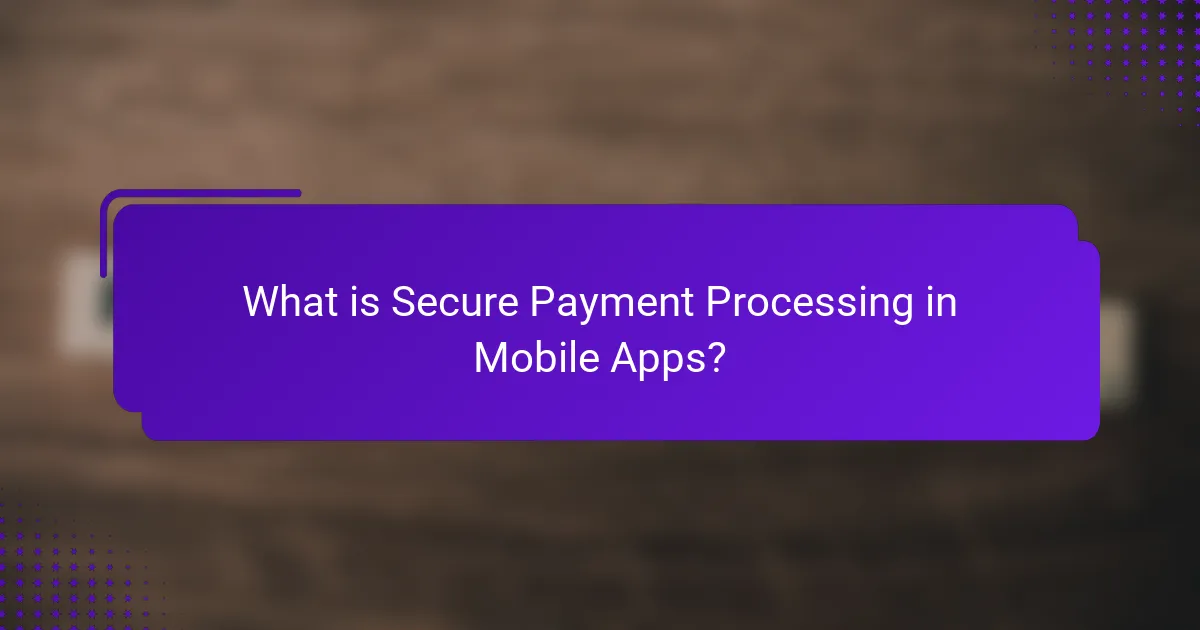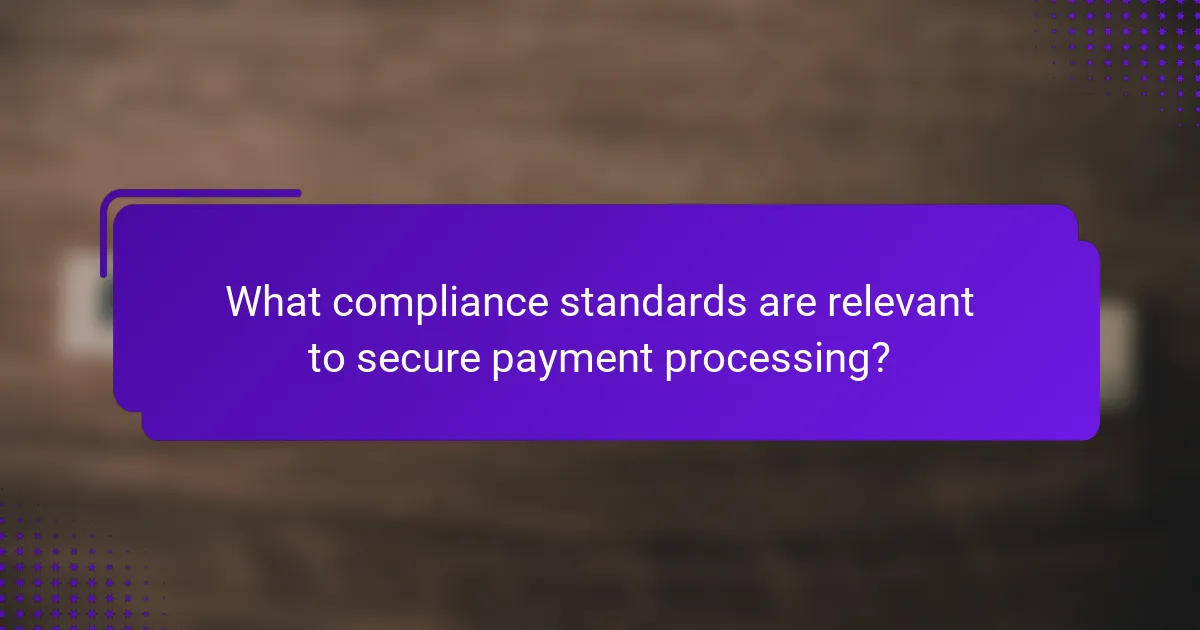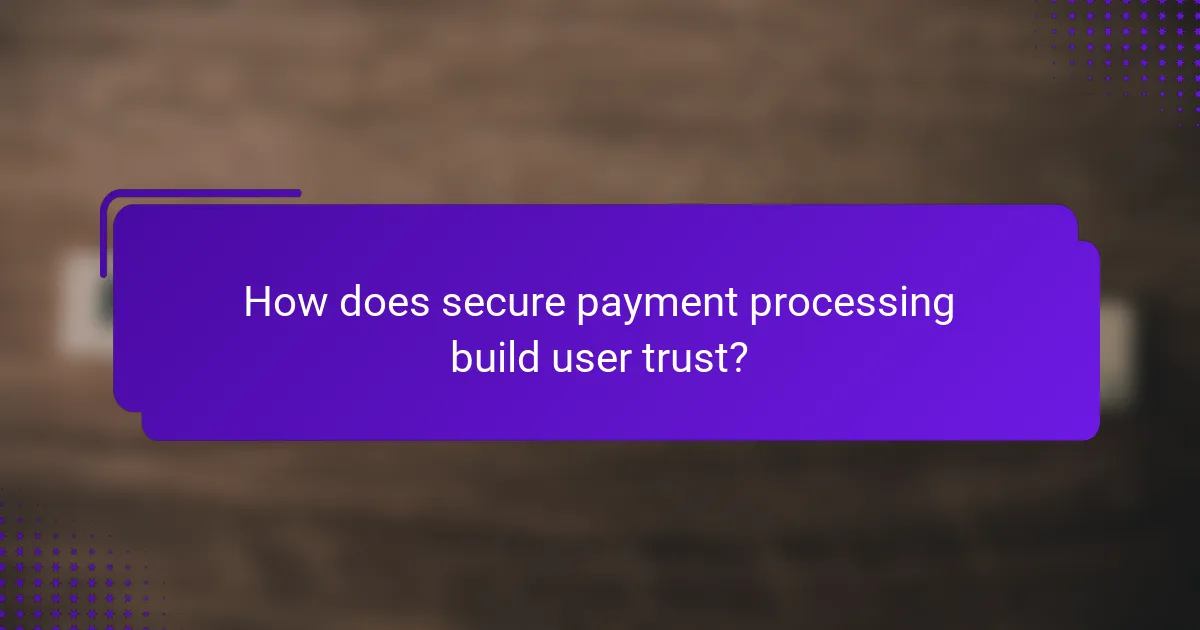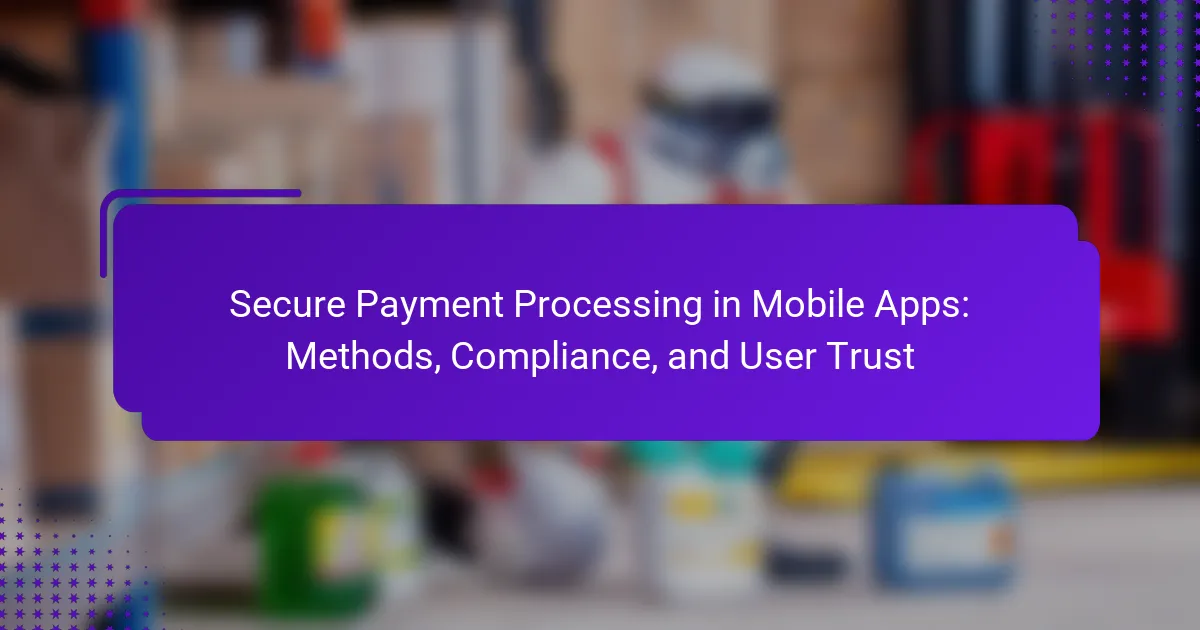Secure payment processing in mobile apps involves the secure handling of financial transactions through methods such as encryption, tokenization, and adherence to compliance standards like PCI DSS, GDPR, and PSD2. Encryption safeguards sensitive data during transmission, while tokenization minimizes exposure by substituting sensitive information with unique identifiers. Compliance with PCI DSS ensures that applications meet essential security requirements for managing cardholder data, significantly reducing the risk of data breaches. This secure processing fosters user trust, as consumers are more likely to complete purchases when they feel their payment information is protected. Furthermore, visible security measures and clear privacy policies enhance user confidence, making secure payment processing critical for user retention and satisfaction.

What is Secure Payment Processing in Mobile Apps?
Secure payment processing in mobile apps refers to the secure handling of financial transactions within mobile applications. This process involves encryption, tokenization, and compliance with standards such as PCI DSS. Encryption protects sensitive data during transmission. Tokenization replaces sensitive information with unique identifiers, reducing exposure. Compliance with PCI DSS ensures that apps meet security standards for handling cardholder data. According to a report by the Payment Card Industry Security Standards Council, adherence to these standards significantly decreases the risk of data breaches. Secure payment processing builds user trust and encourages higher transaction volumes.
How does secure payment processing function within mobile applications?
Secure payment processing in mobile applications functions through encryption, tokenization, and secure communication protocols. Encryption protects sensitive data by converting it into an unreadable format during transmission. Tokenization replaces sensitive information with unique identifiers called tokens, minimizing the risk of data exposure. Secure communication protocols, such as HTTPS, ensure that data exchanged between the mobile app and payment servers remains confidential. Additionally, compliance with standards like PCI DSS (Payment Card Industry Data Security Standard) is crucial for safeguarding user information. These methods collectively enhance user trust by ensuring that transactions are secure and private.
What technologies are involved in secure payment processing?
Secure payment processing involves several key technologies. Encryption is crucial for protecting sensitive data during transactions. Tokenization replaces card details with unique identifiers to enhance security. Secure Socket Layer (SSL) ensures data is transmitted securely over the internet. Payment gateways facilitate the transaction process while maintaining security standards. Two-factor authentication adds an extra layer of verification for users. Compliance with standards like PCI DSS is essential for safeguarding payment information. These technologies work together to ensure secure transactions and protect user data.
How do these technologies enhance security for users?
These technologies enhance security for users by implementing encryption and secure authentication methods. Encryption protects sensitive data during transmission. It ensures that information remains confidential and cannot be intercepted. Secure authentication methods, such as two-factor authentication, add an extra layer of protection. This requires users to verify their identity through multiple means.
Additionally, tokenization replaces sensitive information with unique identifiers. This minimizes the risk of data breaches. Regular security updates and compliance with industry standards further strengthen user security. For example, adherence to the Payment Card Industry Data Security Standard (PCI DSS) ensures robust security measures are in place. These combined technologies significantly reduce the likelihood of fraud and unauthorized access.
Why is secure payment processing important for mobile apps?
Secure payment processing is crucial for mobile apps to protect user financial information. It ensures that sensitive data, such as credit card numbers, is encrypted during transactions. This encryption prevents unauthorized access and reduces the risk of fraud. According to a study by Javelin Strategy & Research, in 2020, 47% of consumers experienced credit card fraud, highlighting the need for security. Additionally, secure payment processing builds user trust. When users feel their information is safe, they are more likely to complete transactions. A survey by PwC found that 73% of consumers would abandon a purchase if they felt their data was not secure. Therefore, secure payment processing is essential for maintaining user confidence and ensuring successful transactions in mobile apps.
What risks are associated with insecure payment processing?
Insecure payment processing exposes businesses and consumers to several significant risks. These include data breaches that can lead to unauthorized access to sensitive financial information. According to a 2020 report by Verizon, 28% of data breaches involved payment card information. Additionally, insecure systems can result in fraudulent transactions, causing financial loss for both merchants and customers. The lack of encryption during transactions can also make data susceptible to interception by cybercriminals. Furthermore, regulatory non-compliance due to inadequate security measures can lead to hefty fines and legal repercussions. The overall impact of these risks can severely damage a company’s reputation and customer trust.
How does secure payment processing protect user data?
Secure payment processing protects user data through encryption, tokenization, and compliance with security standards. Encryption transforms sensitive information into unreadable code. This ensures that even if data is intercepted, it cannot be accessed without the proper decryption key. Tokenization replaces sensitive data with unique identifiers or tokens. These tokens can be used for transactions without exposing actual user data. Compliance with standards such as PCI DSS mandates strict security measures. This includes regular audits and vulnerability assessments to safeguard user information. Studies show that companies using secure payment methods experience fewer data breaches. This reinforces the effectiveness of secure payment processing in protecting user data.
What are the different methods of secure payment processing in mobile apps?
The different methods of secure payment processing in mobile apps include tokenization, encryption, and biometric authentication. Tokenization replaces sensitive card information with unique identifiers. This reduces the risk of data breaches. Encryption secures data during transmission, making it unreadable to unauthorized users. Biometric authentication uses fingerprints or [censured] recognition for secure access. These methods enhance user trust and comply with industry standards. According to a 2022 report by Statista, 50% of mobile users prefer biometric payment methods for their convenience and security.
What are the most common payment methods used in mobile apps?
The most common payment methods used in mobile apps include credit cards, digital wallets, and in-app purchases. Credit cards are widely accepted due to their convenience and security features. Digital wallets, such as PayPal and Apple Pay, offer quick transactions and enhanced user experience. In-app purchases allow users to buy virtual goods or services directly within the app. According to a 2022 report by Statista, credit cards account for approximately 40% of mobile app payments, while digital wallets make up around 30%. These methods are favored for their ease of use and security measures, contributing to user trust in mobile payment processing.
How do these payment methods ensure security?
Payment methods ensure security through encryption, tokenization, and compliance with standards. Encryption protects sensitive data by converting it into a coded format. This makes it unreadable to unauthorized parties. Tokenization replaces sensitive information with unique identifiers, or tokens. These tokens can be used for transactions without exposing actual data. Compliance with standards like PCI DSS ensures that payment processors meet security requirements. These measures significantly reduce the risk of data breaches. According to a study by the International Journal of Information Management, secure payment methods lower fraud rates by up to 30%.

What compliance standards are relevant to secure payment processing?
The compliance standards relevant to secure payment processing include PCI DSS, GDPR, and PSD2. PCI DSS stands for Payment Card Industry Data Security Standard. It mandates security measures for organizations that handle card payments. GDPR, or General Data Protection Regulation, governs data protection and privacy for individuals in the EU. It emphasizes user consent and data security. PSD2, or the Revised Payment Services Directive, enhances consumer protection and promotes innovation in payment services. These standards ensure that payment processing is secure and protects user data effectively.
What are the key compliance regulations governing secure payment processing?
Key compliance regulations governing secure payment processing include the Payment Card Industry Data Security Standard (PCI DSS) and the General Data Protection Regulation (GDPR). PCI DSS sets security standards for organizations that handle credit cards. It mandates measures like encryption and regular security testing. GDPR governs personal data protection in the EU. It requires user consent and data protection measures. Other regulations include the Electronic Fund Transfer Act (EFTA) and the Gramm-Leach-Bliley Act (GLBA). EFTA protects consumers in electronic transactions. GLBA mandates financial institutions to explain their information-sharing practices. Compliance with these regulations is crucial for securing payment processing and protecting user data.
How does PCI DSS affect mobile payment processing?
PCI DSS establishes security standards for mobile payment processing. It mandates that businesses protect cardholder data during transactions. Compliance requires encryption, secure storage, and regular security testing. Mobile payment apps must implement these standards to avoid data breaches. Non-compliance can lead to penalties and loss of customer trust. According to the PCI Security Standards Council, adherence reduces the risk of fraud. Therefore, PCI DSS is crucial for ensuring secure mobile payment environments.
What role does GDPR play in secure payment practices?
GDPR plays a critical role in secure payment practices by enforcing strict regulations on personal data processing. It requires organizations to obtain explicit consent from users before collecting their data. This consent must be informed, meaning users should understand what data is being collected and how it will be used. GDPR mandates that companies implement appropriate security measures to protect personal data. Non-compliance can result in hefty fines, up to 4% of annual global revenue or €20 million, whichever is higher. Organizations must also ensure data portability, allowing users to transfer their data easily. Additionally, GDPR emphasizes the importance of transparency, requiring businesses to disclose data breaches within 72 hours. By adhering to GDPR, companies build user trust, which is essential for secure payment practices.
How can mobile apps achieve compliance in payment processing?
Mobile apps can achieve compliance in payment processing by adhering to industry standards and regulations. They must implement PCI DSS (Payment Card Industry Data Security Standard) requirements. This includes encrypting sensitive data during transmission and storage. Regular security assessments and vulnerability scans are essential for maintaining compliance. Additionally, apps should use secure payment gateways that are PCI-compliant. User authentication measures, such as two-factor authentication, enhance security. Keeping software updated with the latest security patches is also crucial. Compliance not only protects user data but also builds trust in the app.
What steps should developers take to ensure compliance?
Developers should implement a comprehensive compliance strategy. This includes understanding applicable regulations such as PCI DSS and GDPR. They must conduct regular security assessments to identify vulnerabilities. Additionally, developers should integrate encryption protocols for data protection. Training staff on compliance requirements is also essential. Documenting all compliance efforts creates a clear audit trail. Lastly, staying updated on regulatory changes ensures ongoing compliance. These steps collectively help mitigate risks associated with secure payment processing in mobile apps.
How can regular audits help maintain compliance?
Regular audits help maintain compliance by systematically evaluating processes and controls. They identify gaps in adherence to regulatory standards. Regular audits ensure that security measures are in place and functioning effectively. This proactive approach reduces the risk of data breaches. Audits also provide documentation of compliance efforts. This documentation can be crucial during regulatory inspections. Furthermore, audits foster a culture of accountability within organizations. They encourage continuous improvement in compliance practices. Regular audits ultimately enhance user trust in mobile payment systems.

How does secure payment processing build user trust?
Secure payment processing builds user trust by ensuring the safety of financial transactions. Users feel more secure when their payment information is encrypted and protected against fraud. Compliance with industry standards, such as PCI DSS, further enhances this trust. A study by the Ponemon Institute found that 70% of consumers are more likely to complete a purchase if they trust the payment process. Additionally, visible security badges and clear privacy policies contribute to user confidence. When users perceive a low risk of data breaches, they are more inclined to engage with the app. Overall, secure payment processing establishes a foundation of trust essential for user retention and satisfaction.
What factors contribute to user trust in mobile payment systems?
User trust in mobile payment systems is influenced by several key factors. Security measures are paramount; users expect robust encryption and data protection. Transparency in transactions fosters confidence. Clear terms of service and privacy policies are essential. User experience also plays a significant role; intuitive interfaces enhance trust. Customer support availability reassures users during issues. Reputation of the payment service provider affects user perception. Positive user reviews and ratings build credibility. Compliance with regulations like PCI-DSS is critical for establishing trust.
How does transparency in payment processing enhance trust?
Transparency in payment processing enhances trust by providing clear information about transaction details. This clarity allows users to understand fees, terms, and the overall process. When users know how their data is handled, they feel more secure. A study by PwC found that 79% of consumers are more likely to trust companies that are transparent about their practices. Transparency also reduces the risk of fraud, as users can verify transactions easily. This verification builds confidence in the payment system. Overall, transparent practices foster a trusting relationship between users and service providers.
What role do user reviews and ratings play in building trust?
User reviews and ratings significantly contribute to building trust in mobile apps. They provide social proof that influences potential users’ perceptions. Positive reviews can enhance credibility and encourage downloads. Conversely, negative ratings may deter users from engaging with the app. Research indicates that 84% of people trust online reviews as much as personal recommendations. A study by BrightLocal found that 79% of consumers trust online reviews as much as word-of-mouth. This demonstrates the impact of user feedback on decision-making. Overall, user reviews and ratings serve as a vital trust signal in the context of secure payment processing in mobile apps.
How can mobile app developers foster user trust in payment processing?
Mobile app developers can foster user trust in payment processing by implementing robust security measures. Ensuring end-to-end encryption protects sensitive user data during transactions. Compliance with industry standards, such as PCI DSS, demonstrates a commitment to security. Regular security audits can help identify vulnerabilities and enhance protection. Providing clear information about data usage and privacy policies builds transparency. User-friendly interfaces that clearly indicate secure payment methods can increase confidence. Offering multiple trusted payment options caters to user preferences and enhances trust. Lastly, providing responsive customer support can address user concerns promptly, reinforcing trust in the payment process.
What best practices should be followed to enhance security and trust?
Implementing strong encryption is essential to enhance security and trust. Encryption protects sensitive data during transmission and storage. Regularly updating software and systems helps to address vulnerabilities. Conducting security audits identifies weaknesses in the payment processing system. Educating users about security practices fosters a culture of awareness. Utilizing multi-factor authentication adds an additional layer of security. Compliance with industry standards, such as PCI DSS, ensures adherence to best practices. These methods collectively build user confidence in mobile app payment security.
How important is customer support in maintaining user trust?
Customer support is crucial in maintaining user trust. Effective customer support addresses user concerns promptly and accurately. This responsiveness fosters a sense of reliability. According to a survey by HubSpot, 93% of customers are likely to make repeat purchases with companies that offer excellent customer service. Additionally, 60% of consumers have stopped doing business with a brand due to poor customer service experiences. These statistics highlight the direct correlation between customer support and user trust. High-quality support can enhance user satisfaction and loyalty. In the context of secure payment processing in mobile apps, trust is essential for user engagement and retention.
What are some common challenges in secure payment processing for mobile apps?
Common challenges in secure payment processing for mobile apps include data security, user authentication, and regulatory compliance. Data security is critical as mobile apps often handle sensitive financial information. A study by the Ponemon Institute found that 70% of mobile apps have vulnerabilities that can expose user data. User authentication poses challenges due to the need for balancing security and user convenience. Many users prefer simple login methods, which can be less secure. Regulatory compliance is another challenge, as mobile payment systems must adhere to various laws and standards, such as PCI DSS. Non-compliance can lead to significant fines and loss of customer trust. Additionally, the integration of multiple payment gateways can complicate secure processing. Each gateway may have different security measures, making it difficult to maintain a consistent security posture across the app.
How can developers address security vulnerabilities effectively?
Developers can address security vulnerabilities effectively by implementing secure coding practices. They should conduct regular code reviews to identify potential security issues. Utilizing automated security testing tools can help detect vulnerabilities early in the development process. Developers must stay updated on the latest security threats and best practices. Training team members on security awareness is crucial for maintaining a secure development environment. Adopting a secure software development lifecycle (SDLC) ensures that security is integrated at every stage. Following industry standards, such as OWASP guidelines, can provide a framework for addressing vulnerabilities. Regularly patching and updating software is essential to mitigate known security risks.
What strategies can be implemented to combat fraud in mobile payments?
Implementing multi-factor authentication (MFA) is a key strategy to combat fraud in mobile payments. MFA requires users to provide two or more verification factors to gain access. This significantly reduces the likelihood of unauthorized transactions. Additionally, employing machine learning algorithms can enhance fraud detection. These algorithms analyze transaction patterns in real-time. They identify anomalies that may indicate fraudulent activity. Regularly updating security protocols is also essential. This includes encryption standards and compliance with industry regulations. User education on recognizing phishing attempts further strengthens security. Studies show that informed users are less likely to fall prey to fraud. Implementing these strategies collectively creates a robust defense against mobile payment fraud.
What are the future trends in secure payment processing for mobile apps?
Future trends in secure payment processing for mobile apps include increased adoption of biometric authentication. Technologies like fingerprint and [censured] recognition enhance security and user convenience. Another trend is the integration of artificial intelligence for fraud detection. AI can analyze transaction patterns in real-time to identify anomalies. Additionally, the use of blockchain technology is gaining traction. Blockchain offers transparent and tamper-proof transaction records. Mobile wallets are also evolving, providing seamless and secure payment experiences. Compliance with regulations like PSD2 and GDPR will continue to shape payment processing methods. These trends indicate a shift towards more secure, user-friendly payment solutions in mobile applications.
How might emerging technologies impact secure payment processing?
Emerging technologies significantly enhance secure payment processing. They introduce advanced encryption methods, improving data protection during transactions. Technologies like blockchain offer decentralized security, reducing fraud risks. Artificial intelligence detects suspicious activities in real-time, enabling prompt responses. Biometric authentication, such as fingerprint and [censured] recognition, adds an extra layer of security. According to a report by Juniper Research, mobile payment fraud losses are expected to reach $25 billion by 2024, underscoring the need for robust security measures. These technologies collectively strengthen user trust and compliance with regulations in mobile payment systems.
What innovations are on the horizon for enhancing security and user trust?
Innovations on the horizon for enhancing security and user trust include advanced biometric authentication methods. These methods leverage [censured] recognition, fingerprint scanning, and voice recognition to provide secure access. Blockchain technology is also emerging, offering decentralized transaction verification. This enhances transparency and reduces fraud risks. AI-driven fraud detection systems are being developed to analyze transaction patterns in real-time. These systems can identify unusual activities quickly, alerting users and preventing potential breaches. Additionally, end-to-end encryption is becoming standard for protecting user data during transactions. These innovations aim to build greater user confidence in mobile payment systems.
What practical tips can enhance secure payment processing in mobile apps?
Implementing strong encryption protocols enhances secure payment processing in mobile apps. Use Transport Layer Security (TLS) to protect data in transit. Regularly update your app to address security vulnerabilities. Implement two-factor authentication for user verification. Conduct regular security audits to identify potential weaknesses. Limit data storage to only essential information to minimize exposure. Utilize tokenization to replace sensitive data with non-sensitive equivalents. Educate users about secure practices, such as recognizing phishing attempts. These measures collectively strengthen the security framework of mobile payment systems.
How can developers implement multi-factor authentication effectively?
Developers can implement multi-factor authentication effectively by integrating multiple verification methods. They should combine something the user knows, like a password, with something the user has, such as a mobile device. This approach significantly enhances security.
For instance, sending a one-time code via SMS or authentication apps can be an effective second factor. Developers should also ensure that the authentication process is user-friendly to prevent abandonment.
According to a study by Google, multi-factor authentication can block 99.9% of automated attacks. This statistic supports the effectiveness of implementing multi-factor authentication in securing user accounts.
What security measures should be prioritized during app development?
Prioritized security measures during app development include data encryption, secure authentication, and regular security testing. Data encryption protects sensitive information by converting it into a secure format. Secure authentication ensures that only authorized users can access the app. Regular security testing identifies vulnerabilities before deployment. According to the 2021 Verizon Data Breach Investigations Report, 61% of breaches involved credentials. This highlights the importance of strong authentication methods. Implementing these measures helps safeguard user trust and compliance with regulations.
Secure payment processing in mobile apps is the central entity of this article, which explores its methods, compliance requirements, and the impact on user trust. The article outlines key technologies such as encryption and tokenization that enhance security during financial transactions, while also emphasizing the importance of adhering to compliance standards like PCI DSS and GDPR. Additionally, it discusses the role of user trust in mobile payments, highlighting factors that contribute to consumer confidence, including transparency, customer support, and security measures. The content further addresses common challenges and future trends in secure payment processing, providing practical tips for developers to enhance security and compliance.
